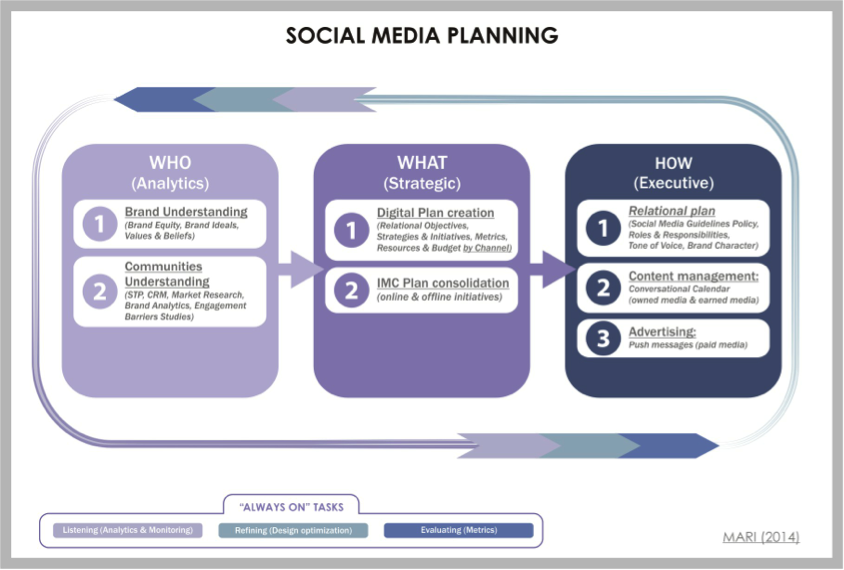The Social Media Plan [Framework]
As a Social Media Manager, you are responsible to ideate and implement a social media plan. Similarly to any other plan, this should be composed by three main parts: analytic (WHO), strategic (WHAT), and executive (HOW).
The definition of your social media strategy starts with the understanding of your brand and the communities you wants to reach. The WHO phase tries to capture all the information related to heritage of your brand, its equity, shared values, beliefs and most importantly of the brand ideals on which your content strategy will be centered (see my previous article ‘Brand Ideals definition’).
A sophisticated understanding of your brand naturally leads you to the analysis of your communities. Previously generated marketing documents that aim at facilitating managers’ understanding of your stakeholders and brand positioning should be properly reviewed ahead of any strategic effort.
Second step of the plan (WHAT), captures all the strategic decisions related to the creation of a Digital Plan. In particular, you must identify, for every single channel, a specific set of relational objectives, stakeholders, strategies and initiatives, metrics, resources and budget.
To make a clear separation between business objectives, communication objectives, and relational objective is rather fundamental at this moment. Despite all three types of objectives must be consistent across the entire brand strategy, a social media manager should be in charge of relational-based objectives specific for social platforms. These are: fostering dialog, promoting advocacy, facilitating support (i.e. customer care), spurring innovation, building conversational leadership, or creating linking value (i.e. supporting many-to-many relationships).
It is never recommended to set all relational objectives together. The main risk is to be on Facebook (or any other social media channel) to do a bit of innovation, customer care, advocacy promotion, dialog creation and community building for all the stakeholders of your company. Instead, the idea is to use a channel with a specific purpose and for a well-defined group of stakeholders, if you want to provide truly valuable content (see @JetBlue customer care for consumerson Twitter).
In the common case that your top management believes that the primary scope of your ‘social’ media plan is to increase sales by 3% or brand recall by 2%, I strongly recommend to quite your company. If fact, the overall objective of social media marketing is to establish and maintain relationships with strategic audiences, and not to sell more (esp. in the short-term).
Now that all elements of your digital plan have been defined, it urges to consolidate your Integrated Marketing Communication plan (IMC) including the whole online / offline initiatives your brand will be undertaking. This is needed to create synergies and to make sure the communication efforts of your company are properly orchestrated.
Last step of the document defines HOW the plan will be implemented to reach the defined relational objectives. This is the executional stage that begins with the understanding (or creation) of:
- Social Media Guidelines & Policy
- Roles & Responsibilities Map
- Branding Guidelines (Personality & Tone of Voice)
- Community Management Guidelines
A Social Media Manager should actively participate to the creation of the above documents or at least have clear visibility on the strategic guidance provided by senior marketing and corporate communication managers.
You will be able to create and promote engaging content for your brand, ideally with the help of a community manager, only after the described steps are concluded. The most critical stage of the HOW section is the creation of content using aconversational/editorial calendar that genuinely delivers value to the defined audience. The very last step (and not the first as several managers wrongly believe)is the paid support (online advertising) aimed at amplifying your brand message.
When the implementation of the plan has begun, it is strategically important to work on the ‘Always On’ tasks: listening (analytics and monitoring), refining (relationship design optimization) and evaluating (metrics) that will structurally improve the overall social media strategy.
Thanks for reading!
Alex Mari - Founder & Creative Director of BrandMate - www.brandmate.it



Comments